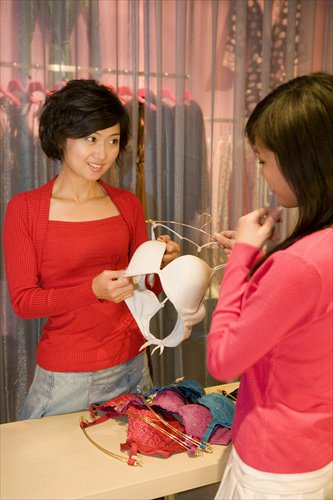HOME >> METRO BEIJING
Caring for your breasts
By Li Lin Source:Global Times Published: 2015-1-20 18:53:02
Measures women can take to reduce the likelihood of breast-related health problems

Some studies suggest that wearing an ill-fitting bra can increase the risk of non-cancerous breast diseases such as mastitis and hyperplasia. Photo: IC
The death of 33-year-old Chinese pop singer Yao Beina from breast cancer late last week has reminded many women of the importance of paying attention to and caring for their breasts.
According to a report jointly published by the International Agency for Research on Cancer and the World Health Organization (WHO) in 2012, breast cancer is the most common cancer in women worldwide, with around 1.7 million new cases each year. China accounts for roughly 187,000, or 12 percent, of new breast cancer cases around the world, according to the report.
While breast cancer receives the most attention, non-cancerous, or benign breast conditions are also common among women. These include fibrosis and cysts, which can cause lumpiness, thickening and swelling of the breasts; hyperplasia, an overgrowth of the cells that line the ducts of a woman's mammary glands; and mastitis, inflammation of the breasts caused by infection.
Know yourself
Wang Ying, a 30-year-old woman who lives in Beijing, recently booked an appointment for a full health checkup, prompted by the news of Yao's death. While breast cancer is typically found in women above the age of 55, other breast conditions, including fibrosis, start to become more common after a woman enters her 30s, according to online health information resource WebMD.
"Recently, I've been touching my breasts several times, because I'm worried that something might be wrong," said Wang. "After I read the tragic news about Yao, I realized that I've been paying too little attention to my breasts, and that I basically know nothing about breast conditions. So I'm going to ask for professional help to take care of them."
In a report published on Sina Health, Luo Bin, director of surgery at Xuanwu Hospital in Beijing, said that besides going in for breast screenings every one to two years, it was important that women were familiar with the normal state of their breasts.
The first step, Luo said, was for women to pay regular attention to their breasts through observation. Women should look for rashes, swelling, breakages, odd discoloration, and engorgement of the veins as signs of abnormality. In addition, the nipples and areola should not be reddened, swollen or sunk. Finally, advised Luo, women should check to see if their breasts are symmetrical and free of lumps.
While breast self-examination (BSE) is no longer recommended by the WHO as a formal means of screening for breast cancer, breast health advocates stress that a familiarity with the normal state of a woman's breast is an important part of overall awareness of breast conditions.
Luo gave advice about feeling for lumps and irregularities in the breasts, but emphasized the importance of structured screenings observed by health professionals.
In an interview with the People's Daily, Xue Mingxing, a breast health specialist at the Hubei Women and Children's Health Hospital, said that the majority of breast conditions were non-cancerous. "If the lump you feel is hard, angular, and cannot be moved easily, it could be cancer, but if it's soft, smooth and round, it is more likely benign," said Xue.
While non-cancerous breast conditions are common, according to Xue, women who discover irregularities should still go to the hospital to seek professional help.

Doctors say that it is important for women over 30 to be familiar with the normal state of their breasts and to undergo regular screenings. Photo: IC
To wear or not to wear a bra
There is a persistent belief in some quarters that wearing a bra can lead to breast cancer. The assertion was first made by self-described "medical anthropologists" Sydney Ross Singer and Soma Grismaijer in a book published in 1995, Dressed To Kill; among its claims were that one in seven women who wore bras for more than 12 hours per day developed breast cancer, and that women who wore a bra for 24 hours a day were 125 times more likely to have breast cancer than those who did not wear a bra at all.
The claim has been widely dismissed by the scientific and medical communities, who note that the studies conducted by Singer and Grismaijer do not account for well-known risk factors for breast cancer such as age at first pregnancy, obesity, diet, or use of medication such as hormone replacement therapy, and that the methodologies used were scientifically unsound.
A formal study over more than 1,500 women published last year by scientific journal Cancer Epidemiology, Biomarkers & Prevention concluded that there was no link between wearing a bra and the risk of breast cancer. Researchers from the Fred Hutchinson Cancer Research Center emphasized that nothing about wearing a bra, from cup size, to the hours per day a bra was worn, to the age a woman started wearing a bra, could be shown to have any correlation with breast cancer.
Nevertheless, the difference between wearing a bra and not wearing a bra, or wearing a correctly fitted bra or an ill-fitting bra, has been linked by some in the medical community to some non-cancerous breast conditions.
Xu Binghe, deputy director of the breast disease department at the Cancer Hospital, Chinese Academy of Medical Sciences, noted in a Life Daily report last December that wearing an underwire bra or a bra that was too tight could hamper blood and lymph circulation, leading to diseases like hyperplasia of the mammary glands. Additionally, the British School of Osteopathy have suggested that wearing a bra that is too constrictive can cause breathing problems and even irritable bowl syndrome.
Jean-Denis Rouillon, a researcher at the University Hospital of Besançon in France, recently released a study advocating not wearing a bra. According to a New York Times report, Rouillon's study, involving 330 women aged 18 to 35, concluded that "medically, physiologically and anatomically," there were no benefits to wearing a bra. Furthermore, some volunteers for the study reported reduced aches and pains after discarding the wearing of their bras, according to the website of French radio channel France Info.
Wang said she had never considered not wearing a bra, but in the aftermath of the story about Yao's death, she had made the effort for the first time in her life to make sure that her bra was correctly fitted. "I searched for information online and finally found the correct way of determining one's bra size. From now on, I'm only going to buy bras from actual shops, instead of buying cheap bras online and having to endure the discomfort."
How to keep your breasts healthy
Among the well-known risk factors for breast diseases, including breast cancer, are a woman's age, pregnancy history, heredity, exposure to radiation or hormonal therapy, and being overweight.
The People's Daily reported in April last year that women who are obese are nearly three and a half times more likely to develop breast cancer. Women who have not had a full-term pregnancy by the age of 30 also face an increased risk of breast cancer.
More recently, a study conducted by doctors from the Sahlgrenska Academy in Gothenburg in Sweden suggested a link between stress and breast cancer. The findings of the study, based on observation of almost 1,500 women over a 24-year period, found that the effects of heightened stress levels on the likelihood of breast cancer due to its effects on hormonal changes were comparable to that of hormone replacement therapy, the People's Daily reported.
Ma Hongmin, director of the breast disease department at Guangzhou Women and Children's Medical Center, also advised women to pay particular attention to their breasts during times of pregnancy and lactation, due to the sharp hormonal changes they bring about in comments made to Nanfang Daily.
"These are the most complicated periods during a woman's life in terms of her breast health," said Ma.
In a journal published by the American Society Cancer, medical experts gave suggestions for reducing the likelihood of breast cancer. The key points were to ensure regular sleeping patterns, to keep a healthy diet, regular exercise, and to reduce intake of alcohol.
Women who sleep less than six hours per night are twice as likely to have breast cancer as those who sleep more than seven hours per night, the report noted. And the risk can be 21 percent higher if a woman drank two glasses of alcohol per day, and drinking can easily cause recurrence of breast cancer for cured women.
Agencies - Global Times
Posted in: Twocents-Opinion